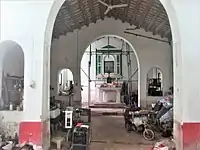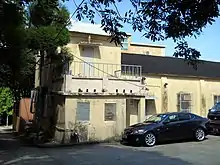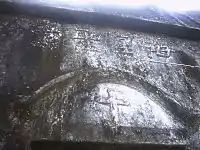
The historic churches of Sai Kung are Roman Catholic churches and chapels established in the 19th and 20th centuries by missionaries in the Sai Kung Peninsula and surrounding islands, across modern day administrative areas: the Sai Kung District and Sai Kung North of Tai Po District.[1]
History
The churches were established by missionaries from the Seminary of Foreign Missions of Milan (now the Pontifical Institute for Foreign Missions).[2] The first missionary to take up residence in Sai Kung Peninsula, in 1865, was Fr. P. Gaetano Origo (1835-1868).[3] A first chapel was opened in the market town of Sai Kung in the late 1865.[4]: 125
- Hakka villages included: Wong Mo Ying, Yim Tin Tsai
- Punti villages included: Chek Keng, Tai Long Tsuen
The Immaculate Heart of Mary Chapel (聖母無玷之心小堂) was built in 1953 in the former village of Sha Tsui (沙咀).[5] It was submerged, together with the village, at the time of the construction of the High Island Reservoir in the 1970s.[6]
List of churches
Note: A territory-wide grade reassessment of historic buildings is ongoing. The churches with a "Not listed" status in the table below are not graded and do not appear in the list of historic buildings considered for grading.
| Location | Notes | Status | References | Photographs |
|---|---|---|---|---|
| Tai Long Tsuen (大浪村), Tai Long Wan 22°25′03″N 114°22′18″E / 22.417524°N 114.371676°E |
Chapel of the Immaculate Conception (聖母無原罪小堂) Built in 1867. |
Grade III | _01.jpg.webp) | |
| Chek Keng 22°25′16″N 114°21′00″E / 22.421198°N 114.349919°E |
Holy Family Chapel (聖家小堂). Built in 1874 to replace an earlier chapel that had been damaged by a storm in 1867. The whole village later converted to Catholicism. During the Japanese Occupation of Hong Kong, the chapel was a base of the Hong Kong-Kowloon Independent Battalion of the East River Guerrilla (東江縱隊港九獨立大隊). | Grade II |  | |
| Tan Ka Wan (蛋家灣) 22°27′05″N 114°21′43″E / 22.451455°N 114.36188°E |
St. Peter's Chapel (聖伯多祿小堂) Built in 1873. It also housed the Sung Ming School (崇明學校). |
Nil grade | ||
| Sham Chung (深涌) 22°26′36″N 114°17′12″E / 22.443210°N 114.286710°E |
Epiphany of Our Lord Chapel (三王來朝小堂) Established in 1879. Rebuilt in 1956.[7] The Chapel housed a school called Kung Man School (公民學校), which had about 50 pupils and two teachers.[8] |
Grade III | _02.jpg.webp) | |
| Pak Sha O (白沙澳) 22°26′52″N 114°19′09″E / 22.44785°N 114.319266°E |
Immaculate Heart of Mary Chapel (聖母無玷之心小堂). A first chapel was built in Pak Sha O in 1880 on another site.[2] The conversion of Pak Sha O into a Catholic village partly resulted from the desire of the villagers to combat the harassment of the tax-lords of Sheung Shui. The current chapel was built between 1915 and 1923. The site is now used as a training campsite by the Catholic Scout Guild. | Grade III |  | |
| Yim Tin Tsai 22°22′39″N 114°18′06″E / 22.377457°N 114.301681°E |
St. Joseph's Chapel (鹽田梓聖若瑟小堂) A first chapel was built in Yim Tin Tsai in 1866.[4] By 1875, the entire community of Yim Tin Tsai had embraced Catholicism.[2] Built in 1890, the current chapel received the Award of Merit by the UNESCO Asia Pacific Heritage Awards for Cultural Heritage Conservation in 2005. |
Grade II |  | |
| Pak Tam Chung (北潭涌) 22°23′30″N 114°19′16″E / 22.391804°N 114.321110°E |
Our Lady of Sorrows Chapel aka. Our Lady of the Seven Sorrows Chapel (聖母七苦小堂) Built in 1900. |
Grade III | _02.jpg.webp) | |
| Pak A (北丫), High Island 22°21′16″N 114°20′58″E / 22.354524°N 114.349386°E |
Lung Shun Wan Mission Centre (龍船灣天主堂) Built in 1910. |
Not listed |  | |
| Long Ke (浪茄) 22°22′35″N 114°22′30″E / 22.376502°N 114.375000°E |
Nativity of Our Lady Chapel (聖母聖誕小堂) Built in 1918. |
Grade III | ||
| Wong Mo Ying (黃毛應), Tai Mong Tsai 22°24′12″N 114°17′43″E / 22.403394°N 114.295251°E |
Rosary Mission Centre (玫瑰小堂) Built in 1940. On 3 February 1942, the Hong Kong-Kowloon Independent Battalion under the People's Anti-Japanese Principal Guerrilla Force of Guangdong, or Dongjiang Guerrilla Force, was established in Wong Mo Ying Church.[9][10] |
Grade II |  | |
| Sai Wan, Tai Long Wan 22°23′45″N 114°22′16″E / 22.395962°N 114.371073°E |
Star of the Sea Chapel aka. Star of the Sea Mass Centre (海星彌撒中心) Built in 1953. |
Pending |  | |
See also
References
- ↑ "District Council Constitutency Boundaries - Tai Po District (Sheet 2)" (PDF). Electoral Affairs Commission. Retrieved 8 February 2021.
- 1 2 3 Heaver, Stuart (27 February 2016). "The abandoned churches of Sai Kung: how Italian missionaries established Hakka congregations in Hong Kong". South China Morning Post.
- ↑ In Memoriam: Fr.P. Gaetano Origo
- 1 2 Ticozzi, Sergio (2008). "The Catholic Church in Nineteenth Century Village Life in Hong Kong" (PDF). Journal of the Royal Asiatic Society Hong Kong Branch. 48: 111–149. ISSN 1991-7295. (A previous version of this paper was presented at a Seminar 'Hong Kong: its people, culture and traditions, the Centre of Asian Studies, University of Hong Kong. 15-16 April 1983)
- ↑ "Immaculate Heart of Mary Chapel" (in Chinese). Catholic Diocese of Hong Kong.
- ↑ "水底有間天主教小堂?". Diocesan Working Committee for "Following Thy Way" (in Chinese). Catholic Diocese of Hong Kong.
- ↑ "Epiphany of Our Lord Chapel" (in Chinese). Hong Kong Catholic Diocesan Archives.
- ↑ Antiquities Advisory Board. Historic Building Appraisal. Old House Ha Wai, Sham Chung Tsuen
- ↑ Chan, Sui-jeung (2009). East River Column: Hong Kong Guerrillas in the Second World War and After. Hong Kong University Press. p. 85. ISBN 9789622098503.
- ↑ Chen Daming, Hong Kong's Anti-Japanese Guerrilla Force (香港抗日游擊隊) (Hong Kong: Universal Press, 2000), pp. 26-27; Choi Chung Man, "Sai Kung People's Support for the Hong Kong-Kowloon Independent Company" (西貢人民對港九大隊的支持), in Chui Yuet Ching, ed., Active in Hong Kong: A Record of Anti-Japanese Efforts of the Hong Kong-Kowloon Independent Battalion in Sai Kung (活躍在 香江:港九大隊西貢地區抗日實錄) (Hong Kong: Joint Publishing, 1993), pp. 168-172. (References cited in The Tai Po Book, p. 205).
Further reading
- Xia, Qilong (1998). The foundation of the Catholic mission in Hong Kong, 1841-1894 (Ph.D. Thesis). The University of Hong Kong.
- von Hübner, Joseph Alexander Graf (1874). A Ramble Round the World, 1871. Macmillan and Co, London; translated by Baroness Mary Elizabeth Herbert. pp. 373-378. (From 23 to 25 November 1871, Count Joseph Alexander Hübner, accompanied by Timoleon Raimondi, visited Christian settlements in the part of China's Xin'an County (Se-non, 新安) that would become the New Territories of Hong Kong in 1898.)
- Constable, Nicole (August 1994). Christian Souls and Chinese Spirits: A Hakka Community in Hong Kong. University of California Press. ISBN 9780520083844. (about a Christian Hakka community in Shung Him Tong Tsuen, Fanling)
- Zhao, Shirley (31 July 2018). "As heritage and historic buildings succumb to redevelopment, is it too late to save old Hong Kong from the wrecking ball?". South China Morning Post.
External links
- Roman Catholic Churches built in Hong Kong (1842-1969)
- "Following Thy Way". thyway.catholic.org.hk (in Chinese). Catholic Diocese of Hong Kong.